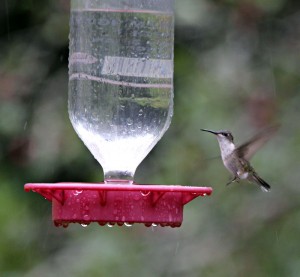 Hummingbirds are a thrill to watch! Their brain is about the size of a BB. The nest is constructed of plant down, spider webs, lichen & tree sap. Hummers eat about every 10 minutes. Their long tongues aid in nectaring. Hummingbirds’hearts are larger proportionally to their body than any other bird or mammal. There are over 325 species of hummingbirds, making them the second largest family of birds in the world, second only to flycatchers.
Hummingbirds are a thrill to watch! Their brain is about the size of a BB. The nest is constructed of plant down, spider webs, lichen & tree sap. Hummers eat about every 10 minutes. Their long tongues aid in nectaring. Hummingbirds’hearts are larger proportionally to their body than any other bird or mammal. There are over 325 species of hummingbirds, making them the second largest family of birds in the world, second only to flycatchers.
Here’s a primer on hummingbird vocabulary. You’ll appreciate these gems more & share their beauty knowing these terms…
Bill – The bony, keratin-covered projection of a bird’s mouth – A hummingbird’s long, thin bill is specially designed for sipping nectar & is one of the most distinctive features of these birds. The length, thickness, color & curve of the bill varies by species.
Dimorphic – The distinct physical differences between genders – Most hummingbird males are brightly colored & iridescent while females are plain, affording them to stay camouflaged while nesting. Young male hummingbirds often resemble females but will attain more color as they mature.
Gorget – The brightly colored throat patch – Many male hummingbirds have distinctly colored gorgets that serve as key field marks for proper
identification based on the gorget’s color & shape. The gorget is often flared to show off its brilliance while breeding or defending territory.
Hyperphagia – A hormonally-induced state of extreme appetite & overeating prior to migration – Hummingbirds may increase their mass by 50 percent or more before migrating so they have enough energy for the journey. Bird feeders are especially important to help hummingbirds gain this weight.
Insectivorous – A diet that consists primarily of insects – While hummingbirds are known for drinking nectar, they also eat a great number of insects as a source of protein, often picking them from spider webs or out of the air. Insects are especially important for young birds so they will develop properly.
Iridescent – Shimmering feathers with metallic-like colors that may change color when seen from different angles – Many hummingbirds have iridescent throats & upperparts, & the exact colors, when seen in good light, are a key to proper hummingbird identification.
Nectar – The sugary water produced by many flowers that is a main food source for hummingbirds – The exact sugar concentration of nectar from different flower types can vary. Use the simple recipe of sugar & water to fill hummingbird feeders ~ no red dye please!
Nectivorous – A diet that consists primarily of nectar – All hummingbirds are nectivorous & may feed dozens of times a day, visiting different flowers & feeders. Hummingbird feeding is important for the pollination of many flowers, & hummingbirds will frequently visit nectar feeders as well.
Guest post by:
Sue McGrath
Newburyport Birders
Observe ~ Appreciate ~ Identify
newburyportbirders@comcast.net
www.newburyportbirders.com
Discover more from Vermont Birder
Subscribe to get the latest posts sent to your email.

Love to learn about the birds we have here — and “hummers” are a favorite! I will be sad when they start “tanking up” for migration, but we can at least provide fuel for the journey and wish them safe travels.